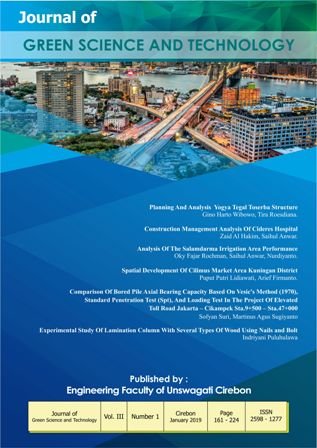THE VARIATION OF ADHESIVE QUANTITY ON PARTICLE BOARDS FROM ARECA NUT SHELL AND MAHANG WOOD POWDER
DOI:
https://doi.org/10.33603/jgst.v2i3.2145Abstract
Particle boards are the solution to the productivity problems of the timber industry which deficiency of raw materials. The manufacture of particle boards from Areca nut shell and Mahang wood powder is an effort to develop existing types of particle boards as well as efforts to utilize areca nut waste and increase the economic value of local wood (Mahang wood). The aim of this study was to determine the effect of quantity variations of adhesive to the composition of the mixture. There are four types of particle board variations are made with the same composition of areca nut and powder but different quantity of adhesive. The determination of physical properties and mechanical properties of particle boards based on JIS A 5908 2003 or SNI 03-2105-2006. The result was an increase in physical and mechanical properties on the particle board whose content of adhesive was greater. The other sides, the mechanical properties of all variations of particle board do not fulfill the existing standards.
Keywords: Areca nut particle board, Mahang wood powder particle board, adhesive content
References
Ariyani MS. 2009. Kualitas papan partikel sabut kelapa (Cocos Nucifera, L). Repository IPB. Bogor
Badan Standarisasi Indonesia (2006), Papan Partikel.SNI 03-2105-2006. BSN. Jakarta, Indonesia.
Fuady (2009) Sifat Fisis dan Mekanis Papan PartikelTandan Sawit dan Kayu Karet, MR Yurizan (2015) Politeknik Sriwijaya.
Haygen dan Bowyer. (1989), Kerapatan Papan Partikel, http://papanpartikelku.blogspot.co.id/2016/04/sifat-fisis-papan-partikel.html, diakses pada tanggal 30 Desember 2017 pukul 09.30 WIB.
Iswanto. (2005), Pengembangan Tebal Papan Partikel, http://juliusthh07.blogspot.com/2010/04/pengembangan-tebal-dan-daya-serap-air.html#ixzz52iyCgnxU, diakses pada tanggal 30 Desember 2017 pukul 10.00 WIB.
Japanese Standart Association. (2003) Japanese Industrial Standard Particle Board JIS A 5908. Tokyo.
Puluhulawa I, dkk. (2018). Pengaruh penambahan baut dan paku terhadap kuat lentur balok laminasi kayu Mahang dan Meranti. Jurnal teknik sipil dan arsitektur (INERSIA). Vol. XIV No.1, 61-74.
Putra Erwinsyah. (2011). Kualitas papan partikel batang bawah, batang atas dan cabang kayu Jabon. Departemen hasil hutan Fakultas Kehutanan Institut Pertanian Bogor.
Widarmana. (1977), Kadar Air Papan Partikel, http://papanpartikelku.blogspot.co.id/2016/04/sifat-fisis-papan-partikel.html, diakses pada tanggal 30 Desember 2017 pukul 09.30 WIB.
Subiyanto. (2003), Daya Serap Air Papan Partikel, http://juliusthh07.blogspot.com/2010/04/pengembangan-tebal-dan-daya-serap-air.html#ixzz52iyCgnxU, diakses pada tanggal 30 Desember 2017 pukul 10.00 WIB.
Sulastiningsih.(2009), Pengaruh Kadar Perekat Terhadap Sifat Papan Partikel Bambu. Bogor. Jurnal PusatPenelitian dan Pengembangan Hasil Hutan.
Sumardi I, (2004). Pengaruh kerapatan dan ukuran partikel terhadap sifat fisis dan mekanis papan partikel kayu suren (Toana Sureni Merr). Proceeding Mapeki VII, Makasar.
Wahyuningsih (2011) Pengaruh Perendaman dan Geometri Partikel Terhadap Kualitas Papan Partikel Sekam Padi. Skripsi. Fakultas Kehutanan. Institut Pertanian Negeri Bogor.
Downloads
Published
Issue
Section
Citation Check
License
- Authors retain copyright and grant the journal right of first publication with the work simultaneously licensed under a Creative Commons Attribution-ShareAlike 4.0 International License that allows others to share and adapt the work with an acknowledgement of the works authorship and initial publication in this journal.
- Authors are able to enter into separate, additional contractual arrangements for the non-exclusive distribution of the journals published version of the work (e.g., post it to an institutional repository or publish it in a book), with an acknowledgement of its initial publication in this journal.
- Upon receiving the proofs, the Author/Editor agrees to promptly check the proofs carefully, correct any errors, and authorize the publication of the corrected proofs.













